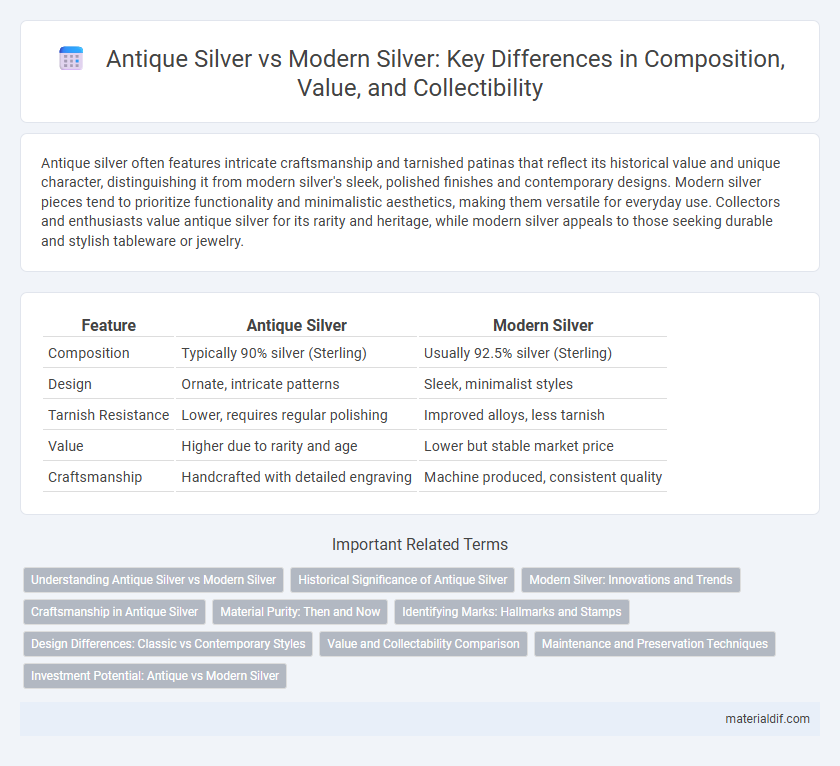Antique silver often features intricate craftsmanship and tarnished patinas that reflect its historical value and unique character, distinguishing it from modern silver's sleek, polished finishes and contemporary designs. Modern silver pieces tend to prioritize functionality and minimalistic aesthetics, making them versatile for everyday use. Collectors and enthusiasts value antique silver for its rarity and heritage, while modern silver appeals to those seeking durable and stylish tableware or jewelry.
Table of Comparison
| Feature | Antique Silver | Modern Silver |
|---|---|---|
| Composition | Typically 90% silver (Sterling) | Usually 92.5% silver (Sterling) |
| Design | Ornate, intricate patterns | Sleek, minimalist styles |
| Tarnish Resistance | Lower, requires regular polishing | Improved alloys, less tarnish |
| Value | Higher due to rarity and age | Lower but stable market price |
| Craftsmanship | Handcrafted with detailed engraving | Machine produced, consistent quality |
Understanding Antique Silver vs Modern Silver
Antique silver typically contains higher silver purity and showcases handcrafted details, often marked by unique hallmarks and patinas that reflect historical manufacturing techniques. Modern silver, such as sterling silver, is standardized at 92.5% silver content with consistent alloy compositions for durability and tarnish resistance. Understanding the differences in craftsmanship, silver content, and hallmarking can help distinguish genuine antique pieces from contemporary silverware.
Historical Significance of Antique Silver
Antique silver holds immense historical significance as it embodies craftsmanship techniques and cultural influences from past centuries, often reflecting the artistic styles of specific eras such as Georgian or Victorian periods. Its unique patina and intricate detailing provide valuable insights into the metallurgy and social customs of historical societies. Collectors and historians highly prize antique silver for its authenticity and ability to connect contemporary observers with tangible narratives of history.
Modern Silver: Innovations and Trends
Modern silver showcases innovative techniques such as advanced electroplating and laser engraving, enhancing durability and intricate design details. Trends include minimalist aesthetics, mixed-metal combinations, and sustainable sourcing practices, reflecting contemporary consumer preferences. Cutting-edge technology also enables customizable silver jewelry, merging tradition with personalization.
Craftsmanship in Antique Silver
Antique silver showcases exceptional craftsmanship characterized by hand-hammered details, intricate engravings, and unique patinas developed over centuries. Artisans of past eras employed traditional techniques such as repousse and chasing, resulting in one-of-a-kind pieces with distinct textures and depth not commonly found in modern silver. The meticulous handwork in antique silver reflects the cultural artistry and skilled labor that modern machine production often lacks.
Material Purity: Then and Now
Antique silver typically contains a higher percentage of pure silver, often around 90% sterling silver, compared to some modern silver alloys that may incorporate additional metals to enhance durability. The traditional 925 hallmark signifies 92.5% silver purity, a standard still maintained today but occasionally surpassed by contemporary metallurgists using advanced refining techniques. Material purity in silver directly impacts its tarnish resistance, value, and suitability for fine jewelry and collectible items.
Identifying Marks: Hallmarks and Stamps
Antique silver pieces typically feature intricate hallmarks that reveal the item's origin, date, purity, and maker's identity, often using symbols unique to specific regions or periods, such as British lion passant or French minerva marks. Modern silver, while still stamped with purity marks like .925 for sterling silver, often includes standardized stamps and fewer complex hallmarks due to updated regulations and mass production practices. Understanding these identifying marks is crucial for authenticating silver items and distinguishing between antique craftsmanship and contemporary manufacturing.
Design Differences: Classic vs Contemporary Styles
Antique silver often features intricate, handcrafted designs with ornate detailing and traditional motifs reflective of historical periods like Victorian or Georgian eras. Modern silver emphasizes sleek, minimalist aesthetics with clean lines and geometric shapes, showcasing contemporary craftsmanship and innovative techniques. The contrast between antique and modern silver highlights a shift from elaborate, decorative artistry to functional and streamlined design preferences.
Value and Collectability Comparison
Antique silver often holds greater value and collectability due to its rarity, historical significance, and unique craftsmanship, making pieces from the 18th and 19th centuries highly sought after by collectors. Modern silver, while more accessible and featuring contemporary designs, typically lacks the distinctive patina and provenance that drive higher market prices in antique silver. Collectors prioritize hallmarks, maker's marks, and condition in antique silver, whereas modern silver's value is primarily influenced by current silver market prices and brand reputation.
Maintenance and Preservation Techniques
Antique silver requires specialized maintenance techniques such as gentle cleaning with natural polishing agents to prevent damage to its intricate patina, whereas modern silver benefits from more frequent polishing using contemporary, non-abrasive products to maintain its luster. Preservation of antique silver emphasizes controlled environmental conditions, including low humidity and stable temperatures, to prevent tarnish and corrosion. Modern silver items, often plated or alloyed, require careful handling and storage in anti-tarnish bags or cloths to extend their lifespan and prevent surface oxidation.
Investment Potential: Antique vs Modern Silver
Antique silver holds significant investment potential due to its historical value, rarity, and craftsmanship, often appreciating over time as collectors seek unique pieces. Modern silver benefits from higher purity standards and contemporary designs, appealing to investors interested in liquidity and market demand. Choosing between antique and modern silver depends on one's investment strategy, balancing long-term value growth with ease of trade in global markets.
Antique Silver vs Modern Silver Infographic

 materialdif.com
materialdif.com